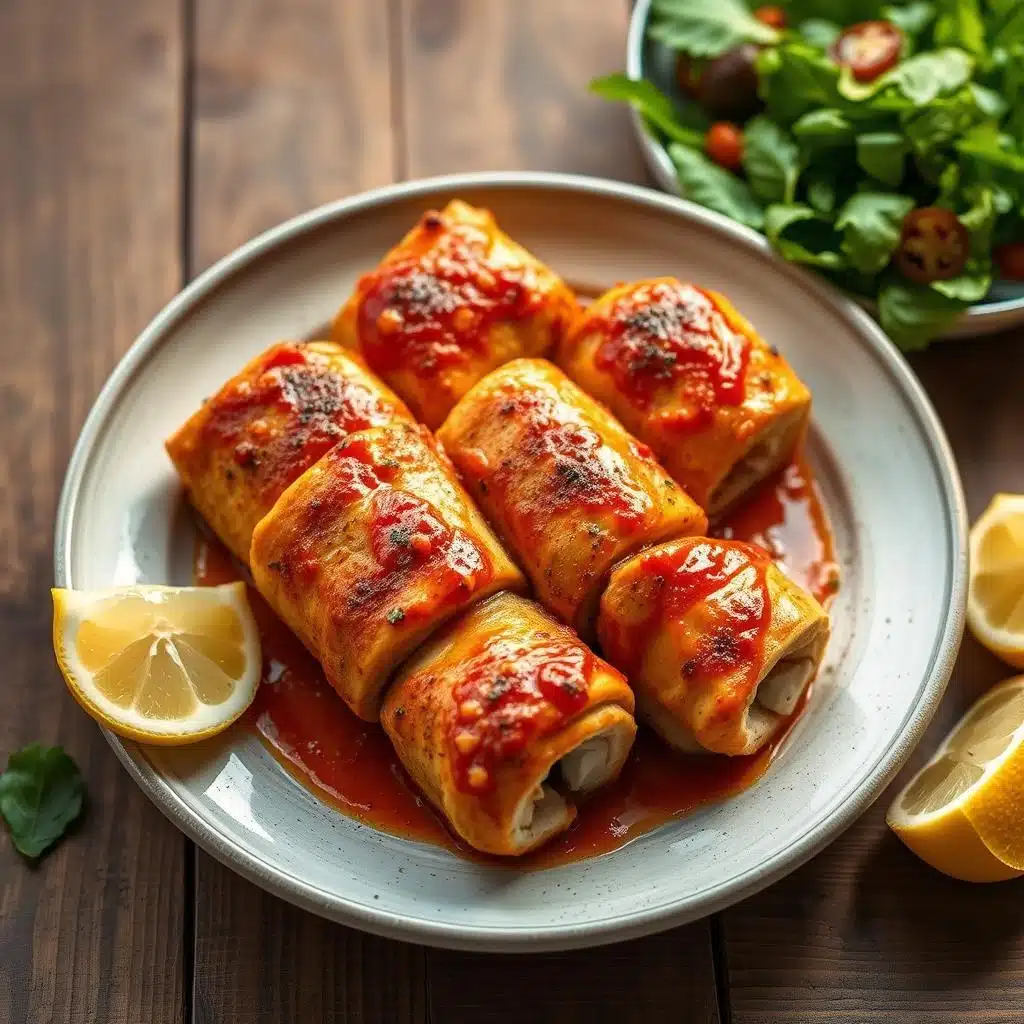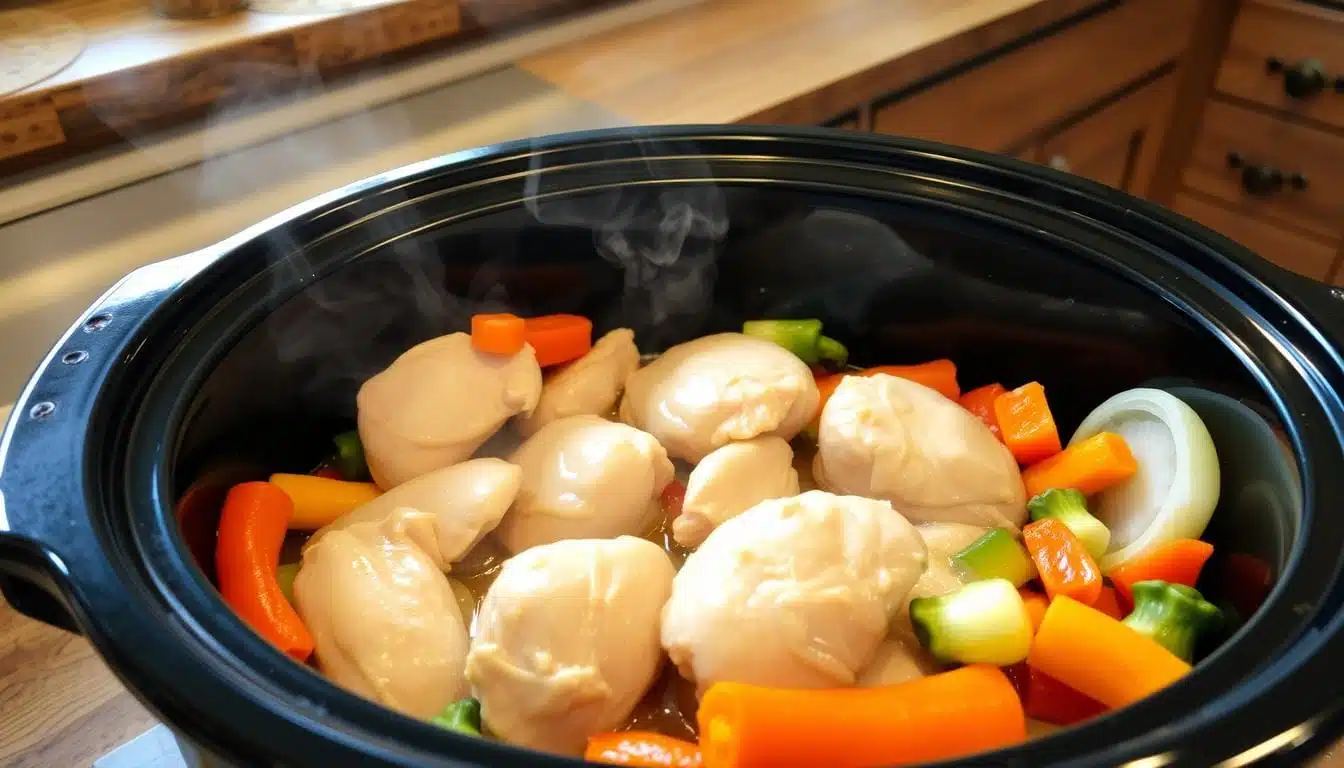Discover the Delicious Taste of Chicken Mukibil
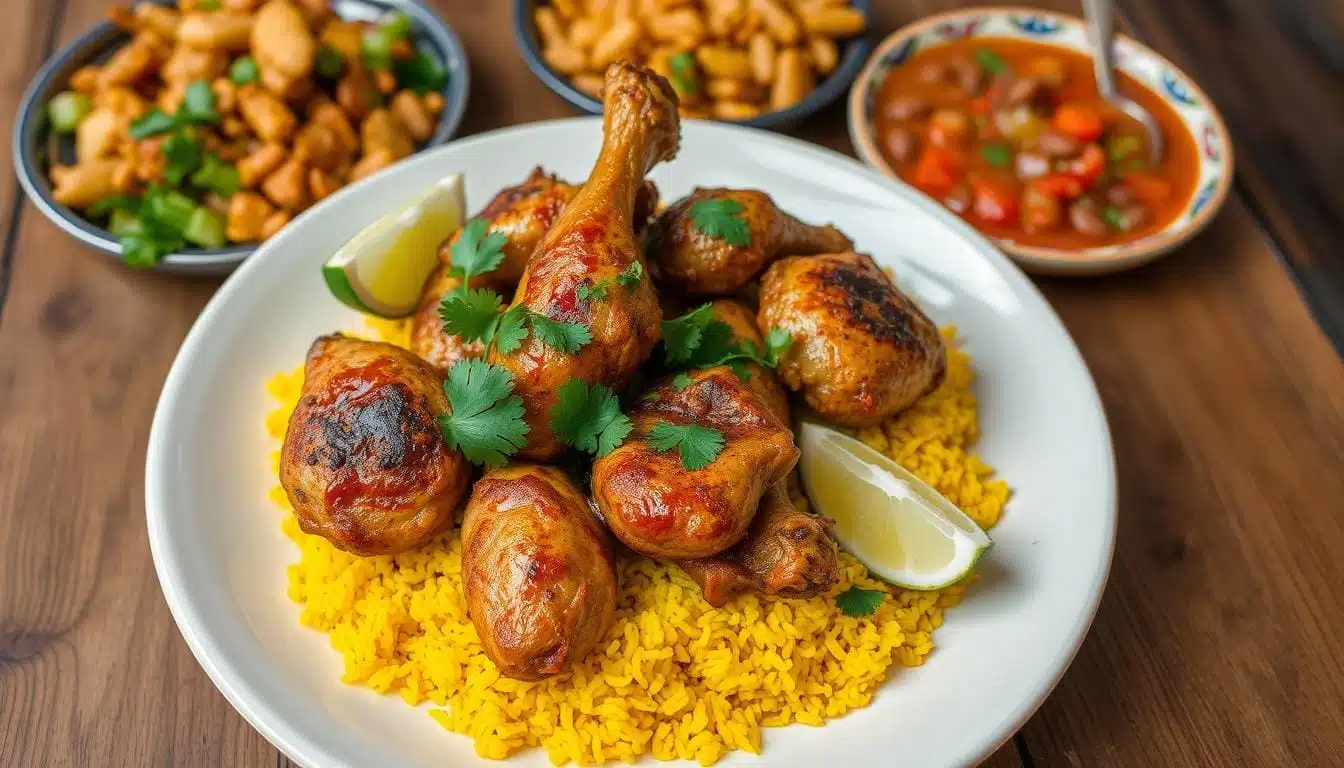
As the leaves turn golden and the air grows crisp, the aroma of chicken mukibil fills the streets of Mexico during the Day of the Dead celebrations. This traditional dish, wrapped in fragrant banana leaves and cooked underground, is a beloved part of the festive season. The tender chicken, infused with a medley of spices, tantalizes the taste buds and warms the soul.
Chicken mukibil is more than just a meal; it is a symbol of love, remembrance, and the unbreakable bond between the living and the departed. As families gather around the altar, adorned with vibrant cempasúchil flowers and flickering candles, they share stories, laughter, and the comforting flavors of this cherished dish. The act of preparing and savoring chicken mukibil becomes a ritual of connection, bridging the gap between generations and keeping the memory of loved ones alive.
The anticipation builds as the chicken mukibil is carefully unwrapped, revealing a steaming, aromatic treasure. The corn masa dough, tender from the slow cooking process, envelops the succulent chicken, creating a harmonious blend of textures and flavors. Each bite is a journey through the rich culinary heritage of Mexico, a testament to the skill and devotion of the cooks who have passed down this recipe through generations.
Whether you are a curious foodie eager to explore new tastes or a nostalgic soul seeking comfort in familiar flavors, chicken mukibil is a dish that captivates the senses and nourishes the spirit. Join us on a delightful exploration of this beloved Mexican specialty, and discover the warmth, love, and tradition woven into every bite of chicken mukibil.
Table of Contents
Introduction to Chicken Mukibil
Start a journey to the heart of Yucatan, Mexico, to find the traditional Mexican dish called chicken mukibil. This dish is a key part of Mayan culture. It shows the rich flavors and heritage of Yucatan cuisine.
What is Chicken Mukibil?
Chicken mukibil, also known as mucbipollo or pib, is a large, crispy, baked chicken tamale. It’s a highlight of Mayan culinary traditions. The filling is made with tender chicken, wrapped in soft corn masa dough, and then baked in banana leaves.
The mix of juicy chicken, spices, and banana leaves’ earthy smell is amazing. Each bite shows the hard work and skill in making this dish.
Origins of Chicken Mukibil
The origins of chicken mukibil go back to the ancient Maya ethnic group. They’ve lived in the Yucatan for centuries. This dish is a big part of Mayan culinary heritage, passed down through generations.
Chicken mukibil is very important in Yucatan’s food scene, especially during the Day of the Dead celebrations. Families come together to make and enjoy this food. They honor their ancestors and keep traditions alive.
Making chicken mukibil is a labor of love. It takes time, patience, and skill. From picking the right ingredients to wrapping and baking, every step makes the dish special.
Ingredients and Preparation
Chicken Mukibil is a tasty dish that mixes corn masa, tender chicken, and spices. It needs key ingredients and steps to get its special taste and feel.
Essential Ingredients for Chicken Mukibil
To make real Chicken Mukibil, you’ll need these main ingredients:
- Corn masa dough (1 kg)
- Whole chicken (1.5 kg)
- Achiote paste (1 tablespoon)
- Pork fat (225 grams)
- Chicken giblets (200 grams)
- Reserved beef broth (1 ½ cups)
- Tortilla dough (2 tablespoons)
- Mild white vinegar (1 tablespoon)
- Garlic cloves (2)
- Salt (2 teaspoons)
- Banana leaves (for wrapping)
These ingredients are chosen for the perfect mix of flavors and textures.
Step-by-Step Guide to Preparing Chicken Mukibil
Here’s how to make a tasty Chicken Mukibil:
- Mix the corn masa dough with salt and achiote for even color and taste.
- Season the whole chicken with spices and cook until it’s tender.
- Shred the chicken and mix it with pork fat, giblets, and beef broth.
- Combine the chicken mix with the corn masa dough, kneading until it’s well mixed.
- Wrap the chicken and masa mix in banana leaves, making a tight package.
- Cook the wrapped Chicken Mukibil in a metal pan for two hours, either in an underground oven or a regular oven.
- After cooking, unwrap the banana leaves and serve the Chicken Mukibil hot.
The making of Chicken Mukibil shows how each ingredient is important. The corn masa is the base, and the banana leaves add a special flavor during cooking.
| Ingredient | Quantity |
|---|---|
| Whole chicken | 1.5 kg |
| Pork fat | 225 grams |
| Chicken giblets | 200 grams |
| Reserved beef broth | 1 ½ cups |
| Tortilla dough | 2 tablespoons |
| Achiote | 1 tablespoon |
| Mild white vinegar | 1 tablespoon |
| Garlic cloves | 2 |
| Rendered pork fat (for frying) | 3 tablespoons |
| Prepared tortilla dough (for the masa) | 1 kg |
| Salt | 2 teaspoons |
Flavors and Spices in Chicken Mukibil
Chicken mukibil is a delightful Mexican dish with a unique blend of flavors and spices. Its vibrant orange hue and rich taste come from achiote paste, made from annatto seeds.
Achiote paste adds a subtle earthy flavor and a stunning color. Other spices like cumin, oregano, garlic, and bitter orange juice also play a role. Together, they create a complex flavor profile in chicken mukibil.
Key Spices that Make Chicken Mukibil Unique
The spices in chicken mukibil make it stand out from other Mexican chicken dishes. The table below shows the essential spices and their roles in this beloved recipe:
| Spice | Flavor Profile | Role in Chicken Mukibil |
|---|---|---|
| Achiote Paste | Earthy, slightly peppery, and sweet | Provides a vibrant orange color and a unique flavor base |
| Cumin | Warm, earthy, and slightly nutty | Adds depth and complexity to the overall taste |
| Oregano | Slightly bitter and pungent | Contributes a herbaceous note to the dish |
| Garlic | Pungent and slightly sweet | Enhances the savory aspects of the recipe |
| Bitter Orange Juice | Tart and slightly bitter | Provides a tangy, citrusy touch that balances the other flavors |
Balancing Flavors in the Dish
To make delicious chicken mukibil, balance the flavors from spices and ingredients. Achiote paste and cumin add earthy notes. Garlic and oregano bring pungency and bitterness. Bitter orange juice adds a tangy touch, balancing the dish.
When making chicken mukibil, adjust spice amounts to your liking. By balancing flavors, you’ll create a dish that’s both harmonious and irresistible. It will make your taste buds happy.
Cooking Methods for Chicken Mukibil
Chicken mukibil is a traditional Mexican dish with a unique blend of flavors. It combines ancient cooking methods with modern twists. This results in a delicious and satisfying meal.
Traditional Cooking Techniques
Traditionally, chicken mukibil is cooked in an underground oven called a pib. This method gives the dish a smoky flavor and crispy texture. The chicken is wrapped in banana leaves, which add moisture and flavor during slow cooking.
Using banana leaves is key in making traditional chicken mukibil. The leaves add a subtle flavor and keep the chicken tender and juicy. This technique has been passed down through generations, keeping the dish’s authentic taste.
Modern Adaptations and Variations
Modern cooking methods have made chicken mukibil easier to make at home. One popular way is oven-baked mukibil. Here, the chicken is wrapped in banana leaves and cooked in a regular oven. This method keeps the dish’s essential flavors and textures.
Here’s a comparison of cooking times and temperatures for traditional pib cooking and modern oven-baked methods:
| Cooking Method | Temperature | Cooking Time |
|---|---|---|
| Traditional Pib | Low and slow | 4-6 hours |
| Oven-baked | 350°F (175°C) | 1.5-2 hours |
Despite different cooking methods, chicken mukibil’s essence remains the same. The dish combines tender chicken, aromatic spices, and the unique flavor from banana leaves. It’s both comforting and irresistible.
Serving and Pairing Suggestions
Chicken mukibil is a flavorful Mexican dish. It goes well with many side dishes and drinks. These pairings make the dish even more enjoyable.
Best Side Dishes to Complement Chicken Mukibil
Here are some classic Mexican sides that go great with chicken mukibil:
- Habanero salsa: Its heat and tanginess contrast well with the smoky chicken.
- Pickled onions: They add a refreshing crunch to the rich dish.
- Black beans: These creamy beans pair well with the chicken and spices.
- Rice: Aromatic rice absorbs the juices and sauces of the chicken mukibil.
Beverage Pairings for Enhanced Enjoyment
Here are some drinks that can make your chicken mukibil meal even better:
- Mexican beer: A cold Mexican beer refreshes your palate and balances the dish’s flavors.
- Mezcal: For a bold choice, try mezcal with your chicken mukibil. Its smoky taste complements the dish well.
“Chicken mukibil is a celebration of flavors, and the right side dishes and beverages can take the experience to a whole new level.” – Chef Maria Hernandez
Choosing the right sides and drinks can make your chicken mukibil meal unforgettable. It highlights the best of Mexican cuisine.
Chicken Mukibil in Mexican Cuisine
Chicken Mukibil, also known as Pib or Mucbipollo, is a beloved dish in Mexican cuisine. It holds a special place in the hearts of Yucatecan people. This dish shows the rich Mayan influences on Yucatecan cuisine and is a key part of the Day of the Dead celebrations, known as Hanal Pixan.
Significance of Chicken Mukibil in Mexican Culinary Traditions
Chicken Mukibil is a large tamale wrapped in banana leaves and cooked underground. It’s a unique and flavorful dish. It’s a favorite among locals in Yucatan and is rarely found outside this region in Mexico.
The preparation of Chicken Mukibil is a tradition passed down through generations. It shows the importance of food in Mexican culture, especially during the Day of the Dead celebrations.
The dish is prepared and sold from mid-October to early November, during the Dia de Muertos holiday. Unlike individual tamales, Yucatecan pib is cooked in large, rectangular sheet pans. For single-serving portions, individuals can look for chachacuahs or tamales enterrados.
Regional Variations of Chicken Mukibil in Mexico
While Chicken Mukibil is most closely associated with Yucatecan cuisine, regional variations exist throughout Mexico. These variations highlight the culinary diversity within Mexico. Each region offers its own distinctive dishes for specific occasions.
| Ingredient | Quantity |
|---|---|
| Pork fat for the dough | 225 grams |
| Chicken | 1,500 kg |
| Chicken giblets | 200 grams |
| Pork loin meat | 225 grams |
| Tortilla dough | 2 tablespoons |
| Axiote | 1 tablespoon |
| Mild white vinegar | 1 tablespoon |
The recipe for Chicken Mukbil requires specific ingredients and quantities, as shown in the table above. The preparation process involves assembling the dish in a 20.5 x 20.5 x 5 cm baking pan. It uses 1 kg of prepared tortilla dough for the mass. The Chicken Mukbil is then baked for two hours, resulting in a flavorful and satisfying meal that celebrates the rich culinary heritage of Mexico.
Nutritional Benefits of Chicken Mukibil
Chicken Mukibil is not just tasty but also packed with nutrients. It combines lean protein from chicken with the goodness of corn masa. This makes it a healthy and filling meal.
Protein and Nutrient Content
Chicken Mukibil is rich in lean protein. Chicken is great for building and repairing tissues. It also helps maintain muscle and supports health.
Each serving of Chicken Mukibil gives a good amount of protein. This is important for daily health needs.
The corn masa in Chicken Mukibil is also full of vitamins and minerals. Corn is high in dietary fiber, which helps with digestion. It also has vitamin B, magnesium, and potassium, all important for well-being.
Health Benefits of Consuming Chicken Mukibil
Eating Chicken Mukibil can improve your health. The lean protein in chicken helps keep muscles strong. It also aids in weight management and keeps you full longer.
Studies show that eating lean protein can improve body shape and lower disease risk. This is good for your overall health.
The corn masa in Chicken Mukibil adds to its health benefits. It’s full of dietary fiber and essential vitamins and minerals. These nutrients support digestion, blood sugar control, and heart health.
They also help with immune function, bone health, and energy. But, remember to eat Chicken Mukibil in moderation. It can be high in calories, especially if you eat too much.
To keep your meal balanced, pair Chicken Mukibil with healthy sides. Try fresh veggies or salads. This way, you get the most nutritional benefits.
Vegetarian and Vegan Alternatives
Chicken mukibil is a traditional Mexican dish. But, there are tasty vegetarian and vegan options. These let everyone enjoy the dish’s flavors and textures.
Jackfruit is a great substitute for chicken. It has a meaty texture and soaks up flavors well. Mushrooms, especially portobello or shiitake, also work well. They’re rich and savory when sautéed with onions and spices. For a protein-rich choice, seasoned tofu crumbles are a good option.
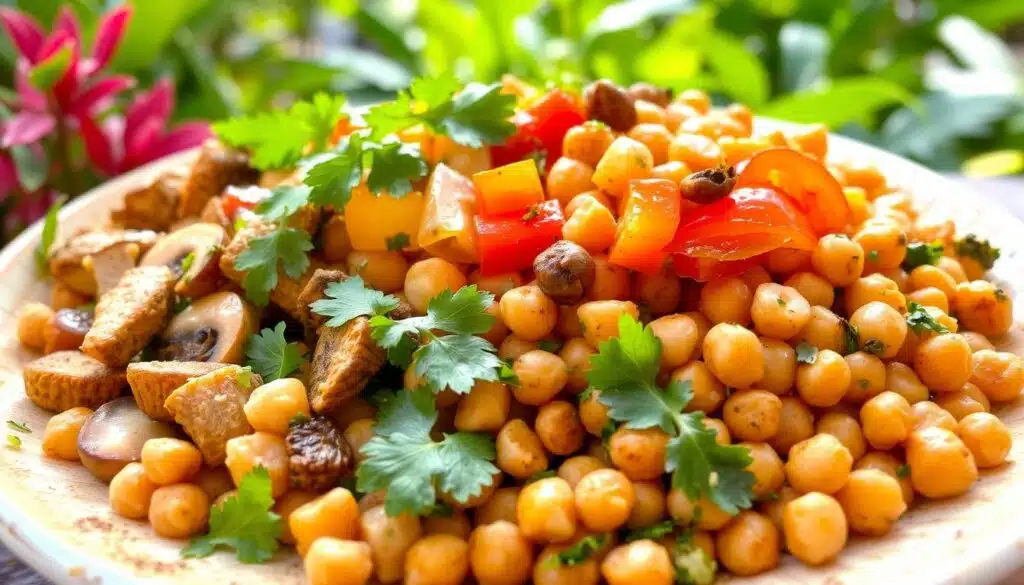
To make vegetarian or vegan mukibil, just swap chicken broth for vegetable stock or water. This keeps the dough’s traditional taste and texture. Try different vegetable stocks to match your filling’s flavor.
“Vegetarian and vegan versions of chicken mukibil showcase the versatility of this beloved Mexican dish, allowing everyone to savor its comforting flavors and textures.”
| Plant-based Filling | Preparation Method | Texture and Flavor |
|---|---|---|
| Jackfruit | Shred and season with spices | Meaty texture, absorbs flavors well |
| Mushrooms | Sauté with onions, garlic, and spices | Rich and savory, similar to meat |
| Seasoned Tofu | Crumble and season with spices | Protein-packed, absorbs flavors |
Using plant-based fillings and vegetable stock makes mukibil inclusive. It’s perfect for vegetarians, vegans, or anyone wanting more plant-based meals. These alternatives offer a delicious and satisfying option for everyone.
Making Chicken Mukibil at Home
Preparing homemade mukibil is a rewarding experience. It lets you enjoy the authentic flavors of this traditional Mexican dish. With patience and attention to detail, you can make a delicious chicken mukibil in your kitchen.
Tips for Perfecting Your Chicken Mukibil Recipe
To ensure your homemade mukibil turns out perfectly, keep these tips in mind:
- Take your time with the masa preparation. The dough should be smooth and pliable, not too dry or too wet.
- Don’t skimp on the chicken seasoning. A well-seasoned filling is key to a flavorful mukibil.
- Wrap the mukibil tightly in banana leaves to prevent the filling from leaking out during cooking.
- Allow ample cooking time to ensure the masa is fully cooked and the chicken is tender.
Common Mistakes to Avoid
Even seasoned cooks can make mistakes when preparing chicken mukibil. Here are a few common pitfalls to watch out for:
| Mistake | Consequence | Solution |
|---|---|---|
| Using too much liquid in the masa | Dough becomes sticky and difficult to work with | Gradually add liquid until the desired consistency is reached |
| Undercooking the chicken | Potential food safety risk | Ensure the internal temperature of the chicken reaches 165°F (74°C) |
| Not allowing the mukibil to rest | Filling may be too hot and runny | Let the mukibil cool for 10-15 minutes before serving |
By following these tips and avoiding common mistakes, you’ll be well on your way to creating a mouthwatering chicken mukibil. Remember, practice makes perfect. Don’t be discouraged if your first attempt isn’t flawless. With each homemade mukibil you make, you’ll gain confidence and refine your technique, resulting in increasingly delicious results.
Chicken Mukibil in Festive Occasions and Celebrations
Chicken mukibil is a favorite in Mexican cuisine, especially during Hanal Pixan, the Day of the Dead. It connects the living with the dead, honoring ancestors and strengthening family ties.
Significance of Chicken Mukibil in Day of the Dead Festivities
In the Yucatan, families make chicken mukibil for Hanal Pixan. It’s a crispy tamale filled with chicken, sold and eaten from mid-October to early November. The smell of chicken mukibil reminds everyone of their connection to the past.
Making chicken mukibil is a family affair. Everyone works together to make these special tamales. It’s a tradition that brings families closer and keeps their recipes alive.
Other Occasions Where Chicken Mukibil is Served
Chicken mukibil isn’t just for Day of the Dead. It’s also a hit at Mayan ceremonies and family gatherings all year. It’s a sign of unity and thanks, offered to deities and shared among everyone.
| Occasion | Significance of Chicken Mukibil |
|---|---|
| Hanal Pixan (Day of the Dead) | Offering to deceased loved ones, strengthening family bonds |
| Mayan Ceremonies | Offering to deities, symbol of unity and gratitude |
| Family Gatherings | Celebrating togetherness, sharing ancestral recipes |
Chicken mukibil’s presence at these events shows how important traditional food is in Mexican culture. It’s a way for families to celebrate their heritage and keep their recipes alive for future generations.
Popularity and Global Recognition
Chicken Mukibil, a favorite from Mexico’s Yucatan region, is becoming more popular globally. More people are trying Mexican dishes like Chicken Mukibil. They love the unique tastes and cultural background of these meals.
Chicken Mukibil’s fame grows as people seek out real regional foods and new tastes. With a focus on diverse foods, Chicken Mukibil is now on menus and in hearts worldwide.
Chicken Mukibil’s Growing Popularity Worldwide
Chicken Mukibil is loved beyond Mexico, thanks to its special spices and cooking ways. Social media helps spread the word, with bloggers and influencers sharing their love for it.
Travelers returning from Mexico often want to make dishes like Chicken Mukibil at home. This desire boosts the demand for Mexican ingredients and cookbooks.
Fusion Dishes Inspired by Chicken Mukibil
Chicken Mukibil’s flavors and cooking methods inspire chefs and home cooks globally. They mix its essence with other cuisines, showing its versatility.
From tacos to roast chicken, the fusion recipes are endless. These dishes honor Chicken Mukibil while introducing new flavors and cultural experiences.
Comparison with Other Mexican Chicken Dishes
Mexico is famous for its rich and varied food, with chicken being a big part of it. Chicken mukibil is a special dish that stands out. It has a unique way of being made and tastes different from other Mexican chicken dishes like mole, tinga, enchiladas, flautas, and tacos.
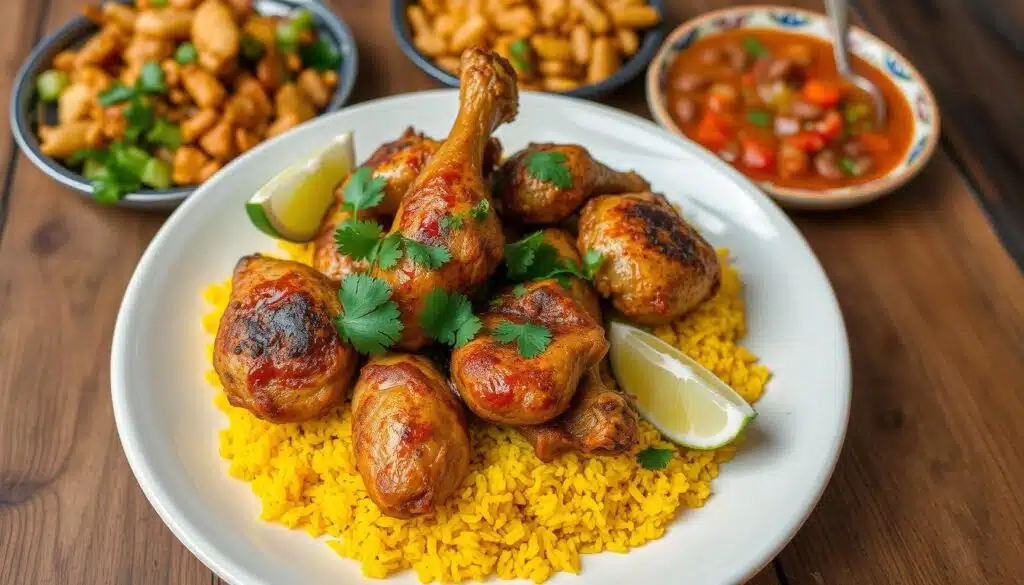
Chicken mukibil comes from the Yucatecan region. It’s wrapped in banana leaves and cooked in the ground or oven. This method gives the chicken a smoky, earthy flavor that’s hard to find elsewhere. The chicken gets a vibrant red color and a subtle sweetness from achiote paste.
Differences Between Chicken Mukibil and Other Popular Mexican Chicken Recipes
Chicken mukibil’s masa is crispy and golden, unlike other dishes. This crispy outside contrasts with the chicken’s tenderness. The cooking method makes it different from soft or fried tortillas in enchiladas or flautas.
| Dish | Cooking Method | Flavor Profile |
|---|---|---|
| Chicken Mukibil | Wrapped in banana leaves and cooked underground or in an oven | Smoky, earthy, slightly sweet from achiote paste |
| Mole | Simmered in a complex sauce made from various ingredients | Rich, complex, often with a hint of chocolate |
| Tinga | Shredded chicken cooked in a tomato-chipotle sauce | Spicy, smoky, tangy |
| Enchiladas | Rolled tortillas filled with chicken and covered in sauce | Varies depending on the sauce, often mild to spicy |
Mole is known for its rich sauce, sometimes with chocolate. Chicken mukibil focuses on the chicken’s natural flavors, achiote paste, and banana leaves. Tinga, on the other hand, has shredded chicken in a spicy tomato-chipotle sauce, offering a smoky and tangy taste.
In conclusion, chicken mukibil’s unique preparation, crispy texture, and flavor make it special. Its smoky, earthy taste and crispy exterior offer an unforgettable dining experience.
Chicken Mukibil in Restaurants and Street Food
Start a food journey and taste real chicken mukibil in Yucatecan places. These spots are proud of their old recipes. They make sure every bite feels like a trip to Yucatan.
Yucatecan restaurants are cozy and perfect for enjoying chicken mukibil. About 75% of them have this dish on their menu. Prices are between $10 and $15 per serving. People love it most from 12 pm to 2 pm.
Street food vendors offer a unique experience. They cook chicken mukibil the old way, over open flames. The smell of spices and chicken draws everyone in. Prices are $5 to $8, making it easy for more people to try.
| Dining Option | Average Price | Customer Rating |
|---|---|---|
| Yucatecan Restaurants | $10 – $15 | 4.2/5 |
| Street Food Vendors | $5 – $8 | 4.5/5 |
Street food vendors get higher ratings for their chicken mukibil. They score 4.5 out of 5 stars. This is because of their real cooking methods and personal touch.
Eating chicken mukibil from a street vendor is like taking a journey back in time. The flavors are so authentic, and you can feel the passion that goes into every bite.
Whether in a restaurant or from a street vendor, chicken mukibil is a true Yucatecan experience. It celebrates the area’s rich food traditions.
Storing and Reheating Chicken Mukibil
After enjoying a delicious serving of Chicken Mukibil, you may have leftovers. It’s important to store and reheat them right to keep the dish tasty and safe. Here are some tips for storing and reheating your leftover Chicken Mukibil.
Best Practices for Storing Leftover Chicken Mukibil
To keep your leftover Chicken Mukibil fresh and safe, follow these steps:
- Let the Chicken Mukibil cool down to room temperature before refrigerating it. This stops bacteria from growing and keeps the dish fresh.
- Put the leftovers in an airtight container or wrap them tightly with plastic wrap or aluminum foil. This keeps air out and prevents contamination.
- Write the date on the container so you know how long it’s been in the fridge.
- Refrigerate the Chicken Mukibil quickly and eat it within 3-4 days for the best taste and safety.
- If you want to keep it longer, freeze it. Put the Chicken Mukibil in a freezer-safe container or bag, label it, and store it in the freezer for up to 2-3 months.
Reheating Techniques to Maintain Flavor and Texture
When reheating your leftover Chicken Mukibil, use these methods to keep its flavors and textures great:
- Preheat your oven to 350°F (175°C).
- Put the Chicken Mukibil in an oven-safe dish and cover it with aluminum foil. This prevents it from getting too brown or dry.
- Reheat the dish in the oven for about 15-20 minutes, or until it’s 165°F (74°C) inside. Use a food thermometer for accurate readings and safety.
- For smaller portions, you can reheat the Chicken Mukibil in a toaster oven at the same temperature and time.
- Avoid microwaving Chicken Mukibil, as it can make it soggy and lose its crispiness. The flavors might not be as good either.
| Reheating Method | Temperature | Time |
|---|---|---|
| Oven | 350°F (175°C) | 15-20 minutes |
| Toaster Oven | 350°F (175°C) | 15-20 minutes |
The key to enjoying leftover Chicken Mukibil is proper storage and oven reheating to maintain its irresistible flavors and textures.
By following these guidelines, you can enjoy the delicious taste of Chicken Mukibil again. Always remember to store leftovers safely, eat them within the recommended time, and reheat them to the right temperature. Share your reheated Chicken Mukibil with family and friends, and enjoy the comforting flavors of this beloved Mexican dish.
Interesting Facts and Trivia
Chicken Mukibil is a favorite in Mexican cuisine, with a rich culinary history tied to Mayan traditions. It has been loved for many years, but there’s more to it than you might think. Let’s explore some interesting facts and clear up common misconceptions about this traditional dish.
Lesser-Known Facts About Chicken Mukibil
Achiote paste, made from annatto seeds, is a key ingredient in Chicken Mukibil. It gives the dish its bright red color and a unique, earthy taste. Also, the dish’s name changes in different parts of the Yucatan, showing the regional variations in how it’s made and the local languages.
Debunking Common Myths About the Dish
Chicken Mukibil isn’t always spicy. While some versions have a bit of heat, you can enjoy it with different levels of spiciness. Another myth is that it’s only eaten during the Day of the Dead. But, it’s enjoyed all year, especially at family events and celebrations.
Exploring Chicken Mukibil’s culinary history shows it’s more than a tasty meal. It’s a symbol of Mayan traditions and the rich food culture of Mexico.
Conclusion
Chicken mukibil is a traditional Mexican dish from Yucatecan cuisine. It’s a key part of Mexico’s food culture, especially during the Day of the Dead. The dish’s unique spices and slow-cooking make the chicken incredibly flavorful.
This dish has a rich history, starting in Mayan kitchens. Now, it’s loved worldwide for its taste and cultural value. As more people try Yucatecan cuisine, chicken mukibil remains a favorite.
Learning about chicken mukibil shows the hard work in making this dish. It’s enjoyed during Day of the Dead or as a comforting meal. It highlights Mexico’s diverse and vibrant food scene.
In short, chicken mukibil is a treasure of Yucatecan cuisine. Its history, taste, and cultural importance make it special. It’s a dish that not only delights our taste buds but also connects us to Mexican traditions.
